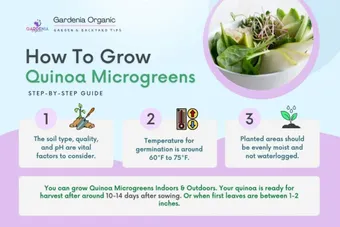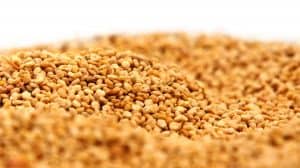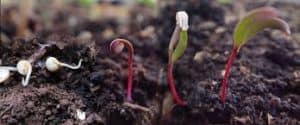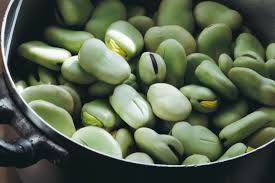Complete Guide on How to Plant Quinoa: [Step by Step + Images]

The quinoa plant (Chenopodium quinoa) is an integral seed that provides lots of benefitsand it has become fashionable, especially in people with a vegetarian or vegan diet.
Among some of the nutritional properties of quinoa, we can find:
- Contains quercetin and kaempferol.
- Contains a high level of plant-based protein.
- It has a high level of minerals, especially magnesium.
- Contains vitamins B-2.
- It has a high fiber content.
- Contains Iron, Phosphorus, Potassium, Zinc, Thiamin, Vitamin B-6 and folic acid.
Important points to keep in mind for Planting Quinoa:
- When? In early spring.
- Where? It requires full sunlight. Although it can withstand sowing in areas with partial shade, it is common for a decrease in the harvest to occur.
 Harvest time? It is ready to be harvested from 90 to 120 days after sowing.
Harvest time? It is ready to be harvested from 90 to 120 days after sowing.- How do we prepare the land? It grows very well in fertile, semi-deep and well-drained soils, although it also develops in slightly more adverse conditions, such as sandy, clayey soils lacking in nutrients, although in these cases, much smaller harvests will be obtained.
- How do we water? It does not require much water, until its flowering. Right now I drip water and every day or every other day.
- How do we harvest? The harvest must be carried out when the grain reaches maturity, approximately seven months after cultivation. This moment is characterized by the fact that the leaves begin to fall and the plant turns a uniform yellow color.
- Favorable associations? Legumes, preferably broad beans, as they fix nitrogen in the soil and thus favor the cultivation of quinoa.
- Plagues and diseases? Birds, aphids, leaf miners, caterpillar, mildew.
With the boom in recent years of alternative diets,Quinoa cultivation has been increasing.It is a very nutritious food, rich in proteins, amino acids and carbohydrates.
Quinoa is an annual plant with wide leaves that can reach up to 3 meters in height. Unlike other grasses, it has the peculiarity of flowering before forming the seed, its flowers are red and are grouped together forming a spike at the end of the stem.Planting quinoa is relatively easy.Here we tell you the essential points for you to do it successfully.
What do we need to grow quinoa?
When should it be sown?
It should be sown in early spring. It is ready to be harvested from 90 to 120 days after sowing.
Where to plant quinoa?
 It requires full sunlight. Although it can withstand sowing in areas with partial shade, it is common for a decrease in the harvest to occur.
It requires full sunlight. Although it can withstand sowing in areas with partial shade, it is common for a decrease in the harvest to occur.
It prefers a relatively cool climate, but does not tolerate frost or very high temperatures. The floor temperature is recommended to be 15°C.
Lower temperatures make the harvest unviable. It also does not grow in temperatures above 30 ºC.
How often should quinoa be watered?
It adapts very well to drought, so its water requirements are not demanding.
As it is sown after spring, it settles for the water it receives from the rain.
We should water them only if the lower layers of the earth begin to dry out. In the flowering season, an increase in irrigation is required.
It can be watered once every 4 or 5 days.
They do not resist waterlogging well and when watering them, it is important to water the soil, not the leaves. For the same, itrecommend drip irrigation.
How do we prepare the land for growing quinoa?
 It grows very well in fertile, semi-deep and well-drained soils, although it also develops in slightly more adverse conditions, such as sandy, clayey soils lacking in nutrients, although in these cases, much smaller harvests will be obtained. Higher yields are obtained when the cultivation is carried out in soft and clean soils. The pH should be slightly acidic, between 6.0 and 6.5
It grows very well in fertile, semi-deep and well-drained soils, although it also develops in slightly more adverse conditions, such as sandy, clayey soils lacking in nutrients, although in these cases, much smaller harvests will be obtained. Higher yields are obtained when the cultivation is carried out in soft and clean soils. The pH should be slightly acidic, between 6.0 and 6.5
What are the most favorable associations for the cultivation of quinoa?
Quinoa can be planted in association with legumes, preferably broad beans, as they fix nitrogen in the soil and thus favor the cultivation of quinoa. It is also convenient to plant it in rotation after the potato, to take advantage of the softness of the ground. It can also be sown in rotation with corn and wheat.
How to sow quinoa step by step
Clear the ground
It extracts weeds and remains of previous crops and all kinds of residues to guarantee that the quinoa receives the adequate amount of nutrients. This is very important, as quinoa grows very slowly and loses nutrients if it competes with faster growing plants.
Also, quinoa comes to resemble weeds, which increases the chances of pulling it up by accident. For this reason, it is important to make sure before sowing that the land is very clean.
Make sure that the plants must be pulled out by the roots to prevent them from growing back.
prepare the ground
Moisten the soil before planting. This will prevent the seed from shifting easily. Make a superficial plow to leave the soil very soft. Fertilize the soil. Make sure you make a good mix of soil with manure to nourish the substrate.
Put the seeds in the ground
Create furrows on the ground, each one 70 cm apart. Place the seeds on the furrow to a depth of 1 cm and cover them with soil. Leave between 30 and 40 cm of distance between each plant.
You can sow multiple seeds in a single hole to increase the chances of germination.
Select the healthiest and strongest seedlings
The seeds will germinate in 5-7 days.If more than one seed has germinated in each hole, keep the strongest one. To do this, do not pull the weak one, as you can damage the leaves. A simple pruning at ground level is sufficient.
Preferably, perform this task when the plant is about 15 cm tall. In this way, you guarantee the integrity of each plant. Once they have reached 30 centimeters in height, the plants will be strong and self-sufficient, and will grow faster.
Make a hill
At 30 days after sowing, the plant requires hilling. The work of ridging consists of collecting soil around the plant and piling it up next to it, forming a mound. If you have planted in rows, form a ridge.
https://www.youtube.com/watch?v=TLrskLrUwEM
How to harvest quinoa
The harvest must be carried out when the grain reaches maturity,approximately seven months after cultivation.This moment is characterized by the fact that the leaves begin to fall and the plant turns a uniform yellow color.
To be sure, dig your fingernail into the pimples. You should feel them plump and juicy. You will find that the seeds are easy to thresh. A simple vigorous shaking is enough to release most of the grains.
Wash them once you’ve collected them all. The leaves are also edible, so you can take advantage of them. Before storing, it is recommended to let the grain dry in the sun. The storage environment should be cool and well ventilated.
Pests and diseases of quinoa
Some of the most common pests and diseases that affect quinoa are:
birds
The birds are the plague thatmore damage causes in the cultivation of quinoa,however, the seeds are covered by a substance called saponin , which is quite bitter and generally prevents birds and other pests from messing with the grains.
To prevent, you can hang pieces of shiny metal or tin sheets that move in the wind from the branches or use a scarecrow.
aphid
It causes the rolling of the leaves and tender shoots. For its control, it is recommended to apply potassium soap and neem oil.
Caterpillar
Some caterpillars and miners can also be attracted, although on a smaller scale, it will usually suffice to eliminate them as we see them. Sprayed Bacillus thuringiensis can control caterpillar attacks.
nematodes
To control them, we can plant garlic cloves as a repellent. They can also be treated with steam sterilization and solarization.
Mildew
To combat it, it is recommended to eliminate weeds and crop debris.Likewise, excess humidity should be avoided, ventilating the crop. Horsetail extract or dusted sulfur can also be applied.

![Photo of Madagascar Jasmine: [Growing, Care, Pests and Diseases]](https://www.complete-gardening.com/wp-content/uploads/2022/08/madagascar-jasmine-growing-care-pests-and-diseases-390x220.jpg)
![Photo of Camellia cuttings: [Concept, Time, Rooting and Sowing]](https://www.complete-gardening.com/wp-content/uploads/2021/06/Como-debemos-tomar-los-esquejes-de-arboles-para-sembrarlos-390x220.jpg)
![Photo of Rosario Plant: [Care, Planting, Irrigation and Substrate]](https://www.complete-gardening.com/wp-content/uploads/2021/06/Senecio__1568323172-390x220.jpg)
